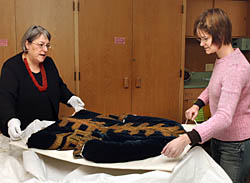Inside Iowa State
Inside ArchivesSubmit newsSend news for Inside to inside@iastate.edu, or call (515) 294-7065. See publication dates, deadlines. About InsideInside Iowa State, a newspaper for faculty and staff, is published by the Office of University Relations. |
November 4, 2005 Morrill renovation is needed boon to clothing collectionby Anne Krapfl A NASA space suit and 1920s drop-waist party dresses and beaded gowns. A 1980s woman's burka from Afghanistan and American gentleman's coats from the early 18th century. Hand--woven head cloths and garments from Africa and Central America. Runway garments created by renowned designer Bonnie Cashin. Pieces of a Roman tunic and a dress formerly owned by ISU alumna and national suffragist Carrie Chapman Catt.  Assistant professor of textiles and clothing Susan Torntore (left) and graduate student Jane Bute lift from its box a properly preserved men's coat dating from the first half of the 18th century.Photo by Bob Elbert It almost sounds like the lineup from a high-stakes masquerade party, but in fact the list is a sampling of the content of Iowa State's Center for Visual Learning in Textiles and Clothing. Or, that's the name it will have officially when it moves into a renovated Morrill Hall in the summer of 2007. For now, it's typically referred to as the historical collection in the textiles and clothing program. According to the hand-written entries in a 3-ring binder, it includes about 7,500 pieces, placing it among the five largest university-owned historical collections in the country. "But I suspect it's closer to 8,500," said Susan Torntore, assistant professor of textiles and clothing and curator of the collection since fall 2003. "I'm still finding pieces in closets and boxes that aren't in the inventory." For now, the collection is in two reclaimed classrooms in LeBaron Hall, in closets, wide metal cabinets and muslin-lined cardboard boxes. Torntore ("torn-TOR-rie") is trained in history, anthropology and textiles conservation and spent more than 15 years in museums in Washington and Wyoming before returning to school for her master's and doctoral degrees in apparel. She has been through building remodels involving museum collections before, three of them, in fact. Even that experience hasn't eliminated some wide-awake-at-4 a.m. moments for her, pondering random details of all that has to get done. The new spaceWhen the $10.2 million Morrill Hall renovation is complete, the Center for Visual Learning in Textiles and Clothing will include:
All of the garments, shoes, hats and textiles from the historical collection will be moved to Morrill Hall. Non-clothing items in the collection, including reference books, historical magazines and catalogs, fashion plates, photographs and research documents, will be housed in a library-like reference center in 2078 LeBaron. "I'm so pleased we'll finally be able to take good care of this collection," Torntore said. "We'll know exactly what we have, and we'll be better able to make it accessible, to have students learn from this collection." Teaching collectionThe garment and textile collection is for teaching purposes. Students learn firsthand, not only about styles and fashion, but workmanship and production of clothes and fabrics, and how they were worn or used. Torntore said at least one course every semester uses the historical collection. Last spring, more than a thousand pieces were examined by students in a 20th century fashion history class. Olive Settle, a faculty member from 1923 to 1962, began the collection when she arrived at Iowa State and is credited with bringing in several hundred items. The oldest items in the collection are fragments of Late Roman-Early Byzantine-era Coptic tunics, dating approximately to the fourth through sixth century. Everything in the collection was donated. Pre-move "to do" listBecause there is no more storage space, donations have stopped for now. Torntore said that until the collections database and move to Morrill are complete, "we won't really know what we have and what areas we might want to add to the collection. "We hope to be more proactive in the future in accepting donations or getting pieces," Torntore said. "We are creating a wish list for items a teaching collection like ours should have." In the meantime, she has applied for a National Endowment for the Humanities grant that would pay for appropriate storage supplies, such as acid-free cardboard boxes and tissue paper and materials to make heavily padded hangers. It also would cover labor costs for graduate students to process and re-house the entire collection. She intends to apply for a grant from the State Historical Society of Iowa that would cover labor costs for undergraduate students to complete an electronic database of the collection, including digital photographs of each piece. She has purchased the camera and will purchase the software to begin that task, and hopes it might be done by the end of 2008. For now, the garments and textiles hang in crowded closets or lie in poster-size cardboard boxes discarded by the bookstore. Many are lined with muslin or acid-free tissue paper to absorb the acid in the wood and paper. "It's in active damage mode right now," Torntore said. "I know that sounds bad, but I also know that resources dictate what happens. "You do what you can, step by step, and plan systematically for a better system. "We're getting there," she added. Editor's note: Other tenants in the renovated Morrill Hall will be University Museums and the Center for Excellence in Learning and Teaching. |
Quote"I'm so pleased we'll finally be able to take good care of this collection. We'll know exactly what we have, and we'll be better able to make it accessible, to have students learn from this collection." Susan Torntore, assistant professor of textiles and clothing |